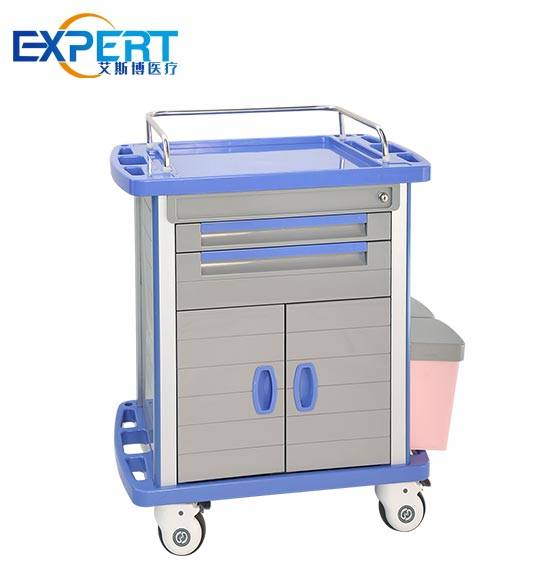Address
304 North Cardinal St.
Dorchester Center, MA 02124
Work Hours
Monday to Friday: 7AM - 7PM
Weekend: 10AM - 5PM
Address
304 North Cardinal St.
Dorchester Center, MA 02124
Work Hours
Monday to Friday: 7AM - 7PM
Weekend: 10AM - 5PM

Medicine trolleys are an essential piece of equipment in healthcare facilities, providing a mobile and organized platform for the secure storage and transportation of medications.

Medicine trolleys are an essential piece of equipment in healthcare facilities, providing a mobile and organized platform for the secure storage and transportation of medications. With various designs and features available, choosing the right trolley can significantly impact the efficiency and safety of medication management. This blog post will explore different medicine trolley options, compare their features, and help you determine which one is the best fit for your facility.
Medicine trolleys play a crucial role in the efficient and effective delivery of healthcare services. These mobile units serve as indispensable tools for healthcare professionals, facilitating the safe storage, organization, and transportation of medications, medical supplies, and equipment within healthcare facilities. The importance of medicine trolleys in healthcare cannot be overstated, as they contribute significantly to patient safety, medication management, and workflow optimization.
One of the primary benefits of medicine trolleys is their role in enhancing patient safety. By providing healthcare staff with easy access to medications at the point of care, trolleys help reduce the risk of medication errors, such as administering the wrong medication or dosage. Moreover, medicine trolleys often feature secure locking mechanisms to prevent unauthorized access to medications, further safeguarding patient wellbeing.
In addition to promoting patient safety, medicine trolleys contribute to efficient medication management practices. Healthcare facilities handle a vast array of medications and medical supplies on a daily basis, and the ability to organize and store these items systematically is paramount. Medicine trolleys are designed with multiple compartments, drawers, and shelves, allowing healthcare professionals to categorize and store medications based on type, dosage, and administration schedule. This organization not only streamlines the medication dispensing process but also helps reduce the risk of medication stockouts or shortages.
The evolution of Medication trolleys represents a significant milestone in the advancement of healthcare infrastructure and patient care delivery. From rudimentary carts to sophisticated mobile units equipped with advanced features, the journey of medicine trolleys reflects the continuous quest for innovation and improvement in healthcare settings.
In the early days of healthcare, Medication trolleys were simple carts or trays used to transport medications and basic medical supplies within hospitals and clinics. These early iterations served a practical purpose but lacked the functionality and efficiency of modern-day trolleys. Over time, as healthcare practices became more complex and patient care standards evolved, so too did the design and functionality of medicine trolleys.
The evolution of Medication trolleys can be attributed to several key factors, including advancements in materials technology, ergonomic design principles, and the integration of innovative features. The introduction of lightweight yet durable materials such as aluminum alloys and ABS plastic revolutionized trolley construction, making them more robust and maneuverable. Ergonomic considerations, such as adjustable height handles and swivel casters, were incorporated to enhance user comfort and ease of navigation.
Consider the material of the trolley and its durability. Stainless steel trolleys are popular for their resistance to corrosion and ease of cleaning, while plastic trolleys may be lighter but less durable.
Evaluate the locking mechanisms available. Some trolleys come with electronic locks for enhanced security, while others have traditional key or combination locks.
Look at the storage capacity and organization options. Trolleys with adjustable shelves and compartments can help optimize space and improve accessibility to medications.
Consider the mobility and maneuverability of the trolley. Wheels with locks and a design that allows for easy turning in tight spaces are essential for busy healthcare environments.
Think about the ergonomics and user comfort. Trolleys with features such as height adjustability and comfortable push handles can reduce strain on healthcare workers.
| Feature | Trolley Option A | Trolley Option B | Trolley Option C |
|---|---|---|---|
| Material | Stainless Steel | Plastic | Aluminum |
| Lock Type | Electronic | Key Lock | Combination Lock |
| Storage | Adjustable Shelves | Fixed Shelves | Limited Compartments |
| Mobility | 5″ Swivel Wheels | 4″ Non-Swivel Wheels | 5″ Swivel Wheels |
| Ergonomics | Height Adjustable | Fixed Height | Limited Adjustability |
| Security | High | Medium | Medium |

When selecting a Medication trolley, consider the following factors:
Choosing the right medicine trolley for your healthcare facility involves a careful evaluation of various factors, including material, security, storage capacity, mobility, ergonomics, and budget. By considering the specific needs of your facility and the feedback of healthcare professionals who will be using the trolley, you can select a medicine trolley that will enhance medication management and contribute to a safer, more efficient healthcare environment.
A: Yes, many manufacturers offer customizable features such as drawer configurations, accessory attachments, and color choices to tailor the trolley to specific facility requirements.
A: The lifespan of a medicine trolley depends on factors such as material quality, usage frequency, and maintenance practices. Generally, well-maintained trolleys can last several years in a healthcare setting.
A: Regular cleaning and disinfection protocols should be implemented following manufacturer recommendations to maintain a hygienic environment and prevent cross-contamination.
A: Many medicine trolleys are equipped with swivel casters or compact designs to facilitate easy navigation through narrow hallways and tight spaces within healthcare facilities.
A: In many regions, medicine trolleys are subject to regulatory requirements and industry standards, such as those outlined by healthcare governing bodies and quality assurance organizations.